Planting Material
Selection of Seed Gardens
- Gardens should have palms with a high proportion of heavy bearers but it should be kept in mind that this must not be from very favourable conditions Garden should be free from the pest and disease incidence.
- Trees growing closer to households, cattle shed, compost pits should be avoided.
- Certain centres are well known for good quality seed nuts and seedlings, e.g., in Kerala, Kuttiadi in Kozhikode and Chavakkad in Thrissur districts.
Mother Palm Selection
For production of quality planting materials it is essential to have good quality mother palms of the desired varieties. In the absence of commercially viable vegetative propagation techniques only seed propagation is possible. Therefore mother palm selection is a key factor in planting material production of coconut.
The important features of superior mother palms are:
- Regular bearer : A good regular bearing mother palm produces on an average one leaf and an inflorescence in its axil every month. So, there will be twelve bunches of varying stages of maturity at any one time with strong bunch stalks. Avoid trees producing habitually barren nuts.
- Straight stout trunk with even growth and closely spaced leaf scars.
- Spherical or semi spherical crown,
- High rate of leaf (more than 30 fully opened leaves) and spathe production (12 inflorescences)
- Short and stout petiole and wide leaf base firmly attached to the stem,
- Short and stout inflorescence stalk with bunches, preferably resting on the leaf petioles of the lower whorl and more number of female flowers (25 or more)
- The age of the palm chosen be middle age i.e., from 25 to 40 years. Even trees with 15 years age can be selected, if it is high yielding and has stabilized yield.(e.g., Chowghat dwarf). Avoid palms that are above 60 years.
- High yielding mother palms giving not less than 100 nuts/palm/annum under irrigated condition (70-80 nuts/annum under rain fed conditions) should be chosen for collecting seednuts
- Husked nuts should weigh not less than 600 g.
- Mean copra content of 150 g per nut or more
- Free from pest and diseases.
Avoid palms which have the following characteristics
- Palms have long, thin and pendulous inflorescence stalks
- Palms produce long, narrow, small sized or barren nuts
- Palms showing alternate bearing tendency also should be avoided.
- Palms show shedding of immature nuts in large numbers and
- Palms are grown under favorable environmental conditions. E.g. Trees near manure pits.

Ideal Mother Palm |

Healthy Coconut Palm |

Regular Bearer |

Unhealthy Coconut Palm |
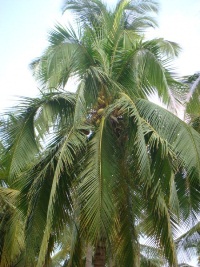
High Rate Leaves |

Spherical Crown |
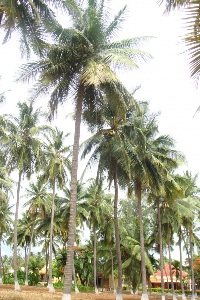
Straight Stout Trunk |
Strategies for Root Wilt Diseased Tracts
In the root wilt disease prevalent tracts, in the midst of heavily diseased palms, high yielding disease free West Coast Tall (WCT), Chowghat green dwarf (CGD) and Chowghat Orange Dwarf (COD) palms are found. Such palms can be selected as mother palms and open pollinated nuts of those palms can be used for large scale planting material production. Seedlings produced from these palms are expected to be high yielding and disease free.
Maturity of Seed Nut
The mature nuts are harvested when at least one nut in the oldest bunch starts becoming dry. In Tall varieties, it takes 11-12 months to become a matured seed nut whereas in dwarfs, nuts will mature in 10-11 months after emergence of the inflorescence. They produce a resonant and ringing sound when hit with the harvesting knife or tapped by finger indicating that the husk is dry. Immature nuts will produce a dull sound. Harvest the bunches intended for seed nut by lowering them to the ground using a rope to avoid injury to seed nuts when palms are tall and ground is hard. The seed nuts should be medium sized, round or oblong in shape.
Selection of Seed Nuts
Harvest seed nuts during the months of February - August in Tamil Nadu, December to May in Kerala to get maximum germination and good quality seedlings. Tall varieties are sown one or two months after collection whereas dwarfs should be sown immediately after harvest (within 10 to 15 days).

Healthy Coconut Fruits |
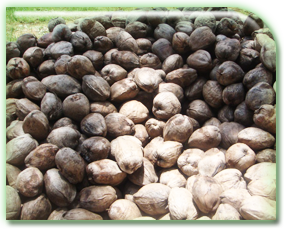
Selected Healthy Nuts |
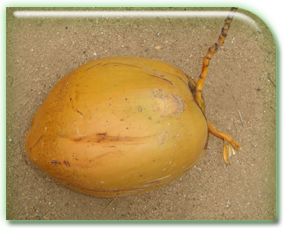
Ideal Seed Nut |
| |
|
|
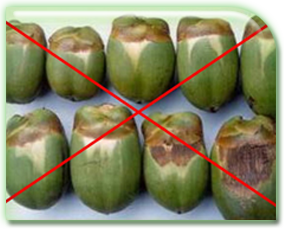
Immature and Disease Affected Coconut Fruits |

Disease Infested Coconut Fruits |

Discarded Seed Nuts |
Storage of Seed Nuts
To get more quality seedlings, the seed nuts of tall and hybrid are to be air cured for one month followed by sand curing for two months. For dwarf varieties, the air curing should be lesser than one month followed by sand curing for two months. In general seed nuts of tall variety are stored up to two months after harvest and dwarfs are sown within 15 days. For storing, arrange the seed nuts with the stalk-end up over an 8 cm layer of sand in a shed and cover with sand to prevent drying of nut water. Up to five layers of nuts can be arranged one over the other. The nuts can also be stored in plots, provided the soil is sandy and the ground is sufficiently shaded. In the case of nuts harvested in May, heap them in partial shade, till husk is well dried and then sow them in the nursery. Nuts without splashing sound indicate that the nut water has become dry and hence they should not be used for sowing.
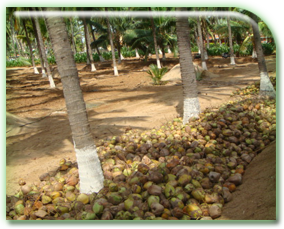
Shaded with Coconut Tree |

Good Storage of Nuts |
Seed Nut Dipping - Dipping in Copperoxychloride (COC)
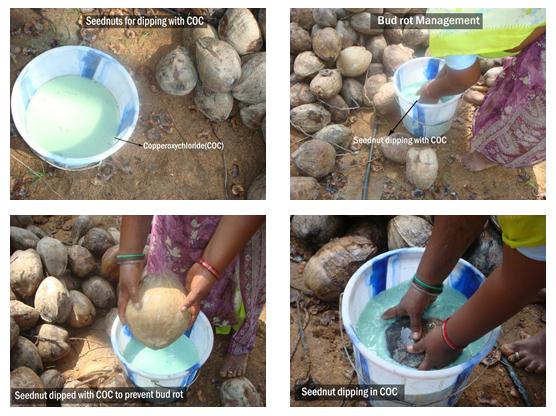 Seed Nut Dipping
Seed Nut Dipping |

